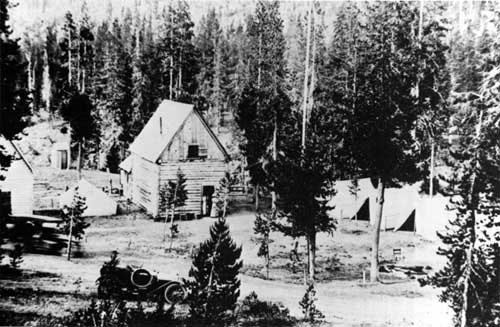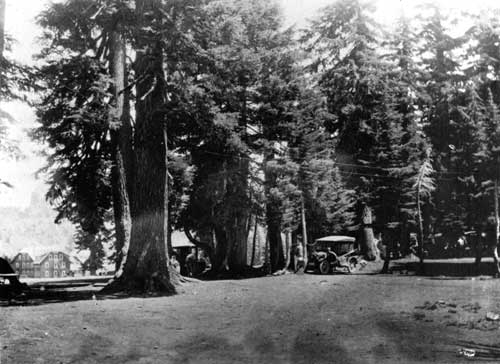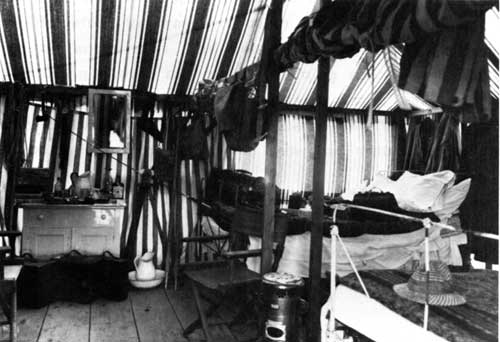|
Crater Lake Historic Resource Study |

|
IX. Trails and
Campgrounds of Crater Lake National Park (continued)
F. Campgrounds
Two campgrounds existed at Crater Lake in 1898, one at the foot of the last hill, on a small stream, about two miles below the lake rim, and the other up at the top on the rim edge. During the summer of 1896 there was a temporary restaurant at the lower camp where board could be had for one dollar per day, although no lodging was provided. [30] By 1909 the Crater Lake Company was maintaining two camps under contract with the Department of the Interior--Camp Arant, near the superintendent's headquarters, and Camp Crater, on the rim of the crater five miles from the former. These two areas advertised accommodations for 544 persons. [31]
In 1913 the two permanent campsites in the park were still functioning and meals were served. Heretofore only tents had been used for sleeping, one visitor to the tent camp on the rim noting that
on account of violent storms prevalent in that vicinity they were found to be unsatisfactory. . . . A few days prior to my arrival, nearly all the tents had been blown down or damaged by a severe wind storm. The sanitary condition of these camps appeared to have been good. . . . The lavatories consisted of out-buildings over sink holes. . . . [32]
At this time, however, work was underway on a handsome stone building that was projected for possible limited use by 1914. A kitchen and dining room would be opened first and then the rooms as they were finished. Two wooden buildings used up to this point as a kitchen and dining room were to be remodeled and used for sleeping quarters. A number of six-room cottages were also planned to shelter guests. [33]
By 1915 the Crater Lake Company still ran two hotel camps, and in addition had boats and launches on the lake. Anna Spring Camp was Located at the head of Annie Creek Canyon where a spring flowed nearly 1,000 gallons a minute. This campground was open July 1 to September 30. A new road finished the year before provided access to the Lake rim five miles away, and daily auto stages ran between the camp and Crater Lake Lodge, leaving at 8:00 a.m. and returning at 5:30 p.m. Tents were provided as sleeping accommodations in connection with the sixty-four-room lodge. There was a general merchandise store at Anna Spring Camp with a branch store at the lodge, where all supplies, including hay, grain, oil, gas, groceries, provisions, cameras, fruits, candies, nuts, tobacco, and drugs could be bought. [34] In 1916 it was reported that there were floored tents for 100 people at the rim and for 50 more at Annie Spring.
A 1918 report of the director of the National Park Service mentions that the public campgrounds on the caldera rim had been improved during the previous season. A tank and pumping equipment were to be installed soon to supply water to campers on the rim grounds, a short distance west of the lodge, "in a beautiful alpine park area commanding a wonderful view of the lake" (in the area of the present picnic grounds). [35] Prior to this improvement water had to be taken from the hotel supply, which had proved inadequate.
Ten years later physical improvements in the park had brought the number of campgrounds to nine: at Wheeler Creek on the east road; at Lost Creek: two at Annie Spring; one below headquarters on the main road; at Cold Spring and Cold Creek, both on the south road; at Whitehorse Creek on the west road; and one at the rim. All boasted various stages of development in proportion to their popularity, ranging from no development at Wheeler Creek to extensive facilities at the rim. [36]

Illustration 23. "Annie Spring Camp." Hotel in center, store in left.
Owned and built by Crater Lake Company, 1909. Courtesy Southern Oregon
Historical Society.

Illustration 24. Rim campground, Crater Lake National Park. Courtesy
Southern Oregon Historical Society.
By 1934 only five of these campgrounds still operated within the park, all free of charge:
1. Rim Campground: on the rim at the terminus of the highway, on a slight elevation in the shelter of a fine stand of mountain hemlock. Eagle Crags, Garfield Peak, and Castle Crest towered to the east. Firewood was available as were sanitary conveniences, including hot water and hot and cold showers. The nearby community house was the gathering place at night for campers and visitors, who enjoyed its big stone fireplace and programs of an entertaining and instructive character provided every evening. Also available was a small dance floor. A post office was provided at the lodge, and cabins could also be rented. A cafeteria and general store were convenient to the camp.
2. Annie Spring Campground: near Annie Spring checking station on highway six miles south of rim camp. Well sheltered, shady spot. Had modern sanitation with running water and wood available. (This campground was eventually closed in 1969).
3. Lost Creek Campground: 3-1/2 miles inside east entrance of park at the junction of the highway entering the park and the rim road, near Sand Creek Canyon. About ten miles from rim of lake.
4. White Horse Campground: fine water and abundant firewood. Three miles inside park boundary and about halfway between west entrance to park and Annie Spring checking station. Trail to Llao's Hallway led off from this point. Nine miles from rim.
5. Cold Spring Campground: five miles from south entrance, three miles below Annie Spring checking station, and nine miles from rim. One of earliest regular camping places of visitors to Crater Lake region. [37]
The new campground at Annie Spring--Mazama Campground--was a Mission 66 project, initiated in the mid-1950s, with the older campground to be used for overflow (closed in 1969). Mazama Campground has 198 units with modern, cold water comfort stations and an amphitheatre for evening programs. It is currently operated by the park concessionaire. Lost Creek Campground offers only twelve spaces.

Illustration 25. Trail to Crater Lake from rim. Courtesy Crater Lake
National Park.

Illustration 26. Interior of tent camp, Crater Lake. Courtesy Klamath
County Museum.
G. Evaluations and Recommendations
The construction of trails in Crater Lake National Park was a continuing process that began near the turn of the century. The first goals were to provide access to the lake edge and then to the summit of Wizard Island. Once these were achieved, trails were built to several of the higher elevations in the park that offered spectacular panoramic views. In the early 1930s Public Works projects included several more new trails that opened up more of the area s natural features to viewing. Trails into the backcountry were developed for the more serious hiker.
Campgrounds were an essential addition to the lake area as soon as steady visitation began in the 1890s. Concession facilities in the form of tent camps were provided in the early 1900s and remained a popular feature even after the Crater Lake Lodge was built. At one time a total of nine campgrounds existed, the most popular being that at the rim, where campers could sleep among the trees and wake up to beautiful sunrises over the lake.
The trails and campgrounds offered added incentive to tourists to visit Crater Lake and the recreational opportunities they offered added immeasurably to visitor enjoyment. None of the trails or campgrounds, however, have historical significance in terms of construction techniques, layout, or location that would justify their nomination to the National Register.
| <<< Previous | <<< Contents >>> | Next >>> |
crla/hrs/hrs9b.htm
Last Updated: 14-Feb-2002